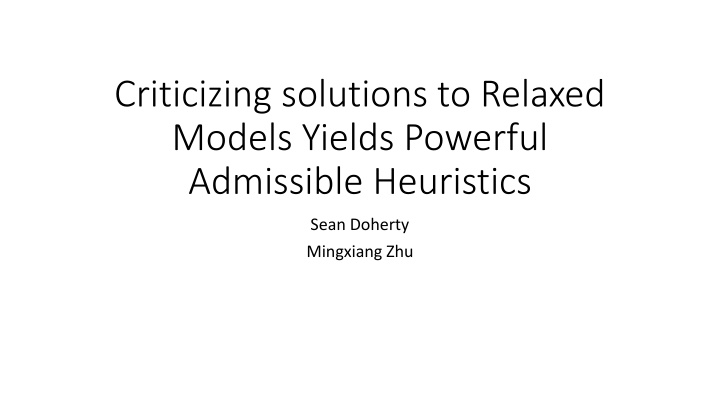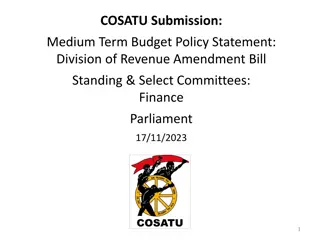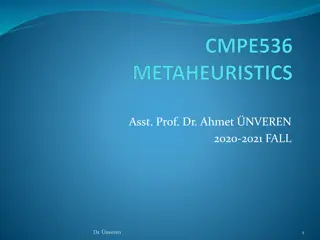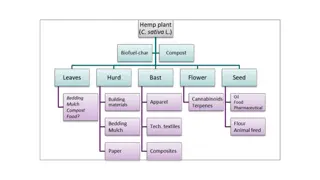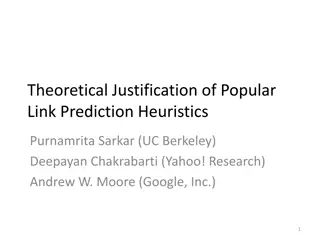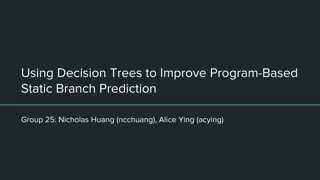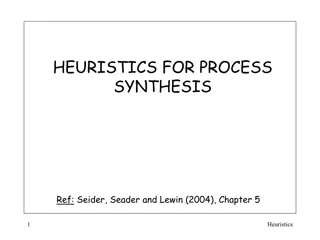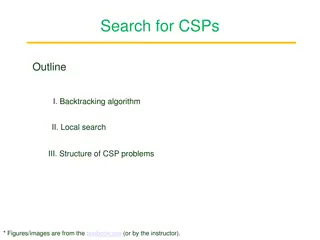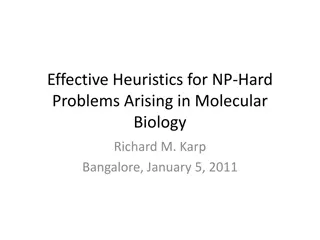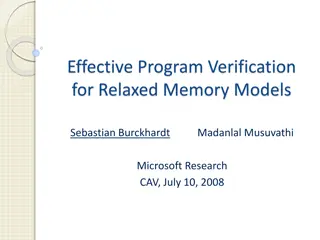Criticizing Solutions to Relaxed Models Yields Powerful Heuristics
The effectiveness of criticizing solutions to relaxed models in generating powerful and admissible heuristics for optimization problems. Dive into concepts like branch-and-bound necessity, optimality in search algorithms, and the application of A* algorithm for finding optimal solutions. Discover how heuristic functions play a crucial role in guiding the search for the best solutions in complex problems like the Traveling Salesman dilemma.
Download Presentation

Please find below an Image/Link to download the presentation.
The content on the website is provided AS IS for your information and personal use only. It may not be sold, licensed, or shared on other websites without obtaining consent from the author.If you encounter any issues during the download, it is possible that the publisher has removed the file from their server.
You are allowed to download the files provided on this website for personal or commercial use, subject to the condition that they are used lawfully. All files are the property of their respective owners.
The content on the website is provided AS IS for your information and personal use only. It may not be sold, licensed, or shared on other websites without obtaining consent from the author.
E N D
Presentation Transcript
Criticizing solutions to Relaxed Models Yields Powerful Admissible Heuristics Sean Doherty Mingxiang Zhu
First Off Branch-and-bound Necessity: No applicable/discovered exact polynomial time solution Admissibility Heuristic function underestimates actual costs Monotonicity Heuristic function does not decrease through successors
Overview of Heuristic Search The state space approach to problem solving Let S be the possible states of the problem Let O be the set of operators or transitions from state to state Let I be the initial state of a problem instance Let G be the set of goal states So : ? ? ?,? ?,? ?
Overview of Heuristic Search(continued) Search problems can be represented as a state-space graph. State is the node, operators are directed, weighted arcs between nodes. The cost to apply an operator is the arc weight. The search problem consists in determining a sequence of operators, ?1,?2, ,??, when applied to I, yields a state in G. Such solution is called a solution path A solution with minimum cost is called optimal. ?=1 ????(??) ?
A* algorithm A* algorithm orders the search by associating each state s with two values: g(s): the length of the shortest path from the initial state to s. h (s): an estimate of the length of the shortest path from s to any goal state[the actual length is h(s)]. A* is an ordered best-first search algorithm, which always examines the successors of the most promising state based on the evaluation function f (s) = g(s) + h (s)
A* algorithm(continued) A heuristic function h (s) is said to be admissible if ? ? ? A heuristic function h (s) is said to be monotone if ?,? [? (?) ? (? )] (where s is a successor of s), because f (s) is determined by h (s). Monotonicity implies admissibility. A heuristic function 1 heuristic function 2 and both are admissible. If A* uses an admissible heuristic, it is guaranteed to find optimal solutions. (?)is said to be more informed than another ? if ?[ 2 (?) 1 (?)] and ?[ 2 (?) 1 (?)]
Traveling-Salesman Problem Combinatorial optimization NP-hard (Exhaustive search would be (n-1)!) Perfect way to express the need of branch-and-bound solutions Hamiltonian circuit n=8 (8-1)! = 5040 . . . (100-1)! = 9.33 e155
TSP & Problem Relaxation Relaxation by constraint deletion What is it? Require a well defined set of states and operators Different relaxations create different models Lets see an example
Operator on state space MOVE(cityi, cityj) Precondition list: Add list: Delete list: Cost: ON(salesman, cityi) VISITED(cityj) ON(salesman, cityj) VISITED(cityj) ON(salesman, cityi) DISTANCE(cityi, cityj)
Bad Relaxation MOVE(cityi, cityj) Precondition list: Add list: Delete list: Cost: ON(salesman, cityi) ON(salesman, cityj) VISITED(cityj) ON(salesman, cityi) DISTANCE(cityi, cityj)
Better choice MOVE(cityi, cityj) Precondition list: Add list: Delete list: Cost: VISITED(cityj) ON(salesman, cityj) VISITED(cityj) ON(salesman, cityi) DISTANCE(cityi, cityj)
Analyzing the Nearest-Neighbor Heuristic Heuristic that can be used that Is easily computable Admissible Conceptually simple But what are the issues?
Criticizing the Nearest-Neighbor Heuristic Disconnection Multiple cycles Starting city/node omitted Result: Held and Karp s minimum-weight 1-tree
Eight puzzle The eight puzzle consists of a 3 3 frame containing eight numbered, sliding tiles. One of the positions in the frame does not contain a tile, which is called the blank. There is one legal operation in this state space which is to slide any one of the tiles which are horizontally or vertically adjacent to the blank into the blank s position. A solution to a problem instance is a sequence of operators which transforms a given initial state into a particular goal state.
Formalization of the problem We use three predicates to describe the problem state of the eight puzzle: ON(x, y): tile x is on the cell y CLEAR(y): cell y is clear of tiles ADJ(y, z): cell y is horizontally or vertically adjacent to cell z
Operator on state space The single operator on the state space is described as: MOVE(x, y ,z) Precondition list: ON(x, y) CLEAR(z) ADJ(y, z) Add list: ON(x, z) CLEAR(y) Delete list: ON(x, y) CLEAR(z) A relaxed model of the problem is created by removing preconditions for this operator.
Heuristics developed via constraint deletion Misplaced tiles Relaxed adjacency Manhattan distance
Misplaced tiles The most severe relaxation is to delete both ADJ(y, z) and CLEAR(z). In this model, any tile in any position may be moved into any other position, with stacking allowed. The obvious solution is to move each tile from its current position into its goal position. Thus, the length of the optimal solution is merely the number of tiles which are not currently in their goal positions the misplaced tiles.
Relaxed Adjacency If we delete only the ADJ(y, z) from the list of preconditions. In which, any tile, anywhere may swap positions with the blank. In this relaxed-adjacency model, optimal solution is as following: While any tile is out of its goal position do: if the blank is in its own goal position: then swap with any misplaced tile else swap with the tile that belongs in the blank s position
Manhattan distance If CLEAR(z) is deleted, the optimal solution length is given by the familiar Manhattan-distance heuristic. In which, a tile may be moved into any horizontally or vertically adjacent position, with stacking allowed. The optimal solution to this problem is found by moving each tile along a shortest path between its initial and goal positions. For any one tile, the length of this shortest path is the grid distance(horizontal plus vertical distance) between its current and goal positions.
Refining relaxed models by solution criticism We have seen how constraint deletion can generate a number of admissible heuristics for the eight puzzle. The different relaxations discussed above are weighted heavily towards certain properties: the shortest path and the role of blank in moving the tiles Intuitively, Manhattan distance is the best of the heuristics discussed above.
Analyzing Manhattan distance solution Manhattan distance proposes that the puzzle can be solved by moving each tile along a shortest path to its goal position. More specifically, the optimal solution in the model is a set of subgoal solutions, one for each tile. In many cases, the tile is already in its correct row or column and need only move within that row or column In other cases, the path is not unique.
continued Lemma 1: If there exists one path from position X to position Y in the eight puzzle that is of even (odd) length, then all paths from X to Y are of even (odd) length Corollary to lemma 1: If there is a unique shortest path p between position X and position Y in the eight puzzle, then any alternate path will be at least 2 moves longer than p.
Example of conflicting shortest paths(continued) A: either 5 or the 3 must move outside the middle row, two more steps will be added B: either 4 or 3 will have to follow a non-shortest path. Adding at least 2 moves to the Manhattan distance estimate. C: the tile 5 is in conflict with the 3 and the 4, either the 5 has to move out of the way adding 2 steps, or both the 3 and the 4 have to move adding 4 steps D: each tile in the middle row is in conflict with the other two, so two tiles have to be move out the middle row adding 4 steps.
Linear Conflict Heuristic Intuitively, one can estimate the puzzle state, row by row, column by column, and adds to the Manhattan distance the minimum number of additional moves necessary to resolve the conflicts within each row and column. Linear conflict estimate is still a lower bound on the actual optimal solution length.
References Othar Hansson, Andrew Mayer, Moti Yung. "Criticizing Solutions to Relaxed Models Yields Powerful Admissible Heuristics." Information Sciences, 63 (September 15, 1992), 207- 227
